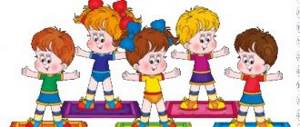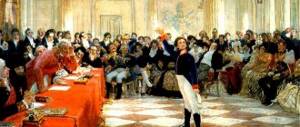Speech on the topic: “Road rules in kindergarten” material on the topic
MUNICIPAL BUDGET PRESCHOOL INSTITUTION
"ATEMARSKY KINDERGARTEN No. 1 "TEREMOK" LYAMBIRSKY MUNICIPAL
DISTRICT OF THE REPUBLIC OF MORDOVIA
PERFORMANCE
ON THE TOPIC OF:
“ROAD RULES IN KINDERGARTEN”
Prepared by: Lobanova N.N. – teacher of the first qualification category
Every year the intensity of transport on Russian roads increases, and at the same time the number of road accidents increases. The increase in the number of injured children is of particular concern. Therefore, familiarizing preschoolers with the rules of road injuries plays an important role in preventing injuries on the roads. Familiarizing preschoolers with the rules of the road plays an important role in preventing injuries on the roads. Our kindergarten teachers are doing a lot of work in this direction.
The traffic rules are the same for children and adults; they are written in “adult” language without any consideration for children. It is known that habits established in childhood remain for life. That's why we teach children traffic rules from a very early age. Our parents, all specialists and educators, the school, as well as all the people around the child take part in this.
We educate preschoolers about safe behavior on the roads in several ways. First of all, through direct perception of the world around us, during which children actively get acquainted with various road situations, perceive and name objects, phenomena, actions of people, their relationships with each other, analyze these relationships and draw conclusions.
The second way is to understand reality through the stories of parents and educators, through classes, reading fiction, watching television programs and videos, and through outdoor games.
Today, the kindergarten strives to provide its pupils with a high-quality, universal education, to ensure a high level of general culture, including culture on the road. Compliance with life safety rules should become a conscious necessity.
Therefore, the main task of educators is to clearly explain the rules to the child, and when choosing a form of education, to convey to children the meaning of the danger of non-compliance with the rules, without distorting their content. Children need to be taught not only traffic rules, but also safe behavior on the streets, roads, and in transport.
In our kindergarten, a lot of work has been done to familiarize preschoolers with the rules of the road: conversations, discussions of situations, observations, excursions, memorization of poems, reading literary texts, and board educational games. To make children more interested in traffic rules, attributes for role-playing games on traffic rules and teaching aids were produced. The development environment for teaching the basics of road safety in groups is constantly being updated: city street layouts, transport sets, road signs, traffic lights, attributes for role-playing games,
Particular attention is paid to working with the parents of our students.
At the beginning of the school year, parents are surveyed on the topic: “Me and my child on the city street.” From this survey we will find out the attitude of parents towards traffic rules. The survey results showed that there is a need to study traffic rules not only in kindergarten, but also at home with parents. During the conversation, it became clear that parents do not always cross the road at a pedestrian crossing, guided by the green traffic light, and not all parents explain to their children the meaning of road signs.
The active participation of parents is manifested in such forms of joint work between adults and children as the creation of wall newspapers, photo newspapers, and photo albums. During the school year, general holidays and entertainment with parents are held: “Good Road to Childhood”, “Road Certificate”. Such holidays bring great joy to children.
Teachers need to know the traffic rules for pedestrians and the requirements for moving with a group of children on the streets, roads and in transport.
A group of children may only be driven along the sidewalk or left shoulder, no more than two rows apart, accompanied by three adults. It is advisable that children do not have any objects in their hands.
Crossing the street is permitted only in places where there are lines or signs, or at intersections along the continuation of sidewalks. At the same time, the teacher, having reached the middle of the road, warns transport drivers with a raised red flag about a column of children crossing the street until the children pass.
Teachers must remember that in the process of teaching children the rules of the road, one cannot limit oneself to verbal explanations only. A significant place should be given to practical forms of learning: observations, excursions, targeted walks, during which children learn in practice the rules for pedestrians, observe road traffic, and consolidate previously acquired knowledge.
The movement of vehicles and pedestrians on streets and roads is too complex a phenomenon for children to navigate on their own. Therefore, special attention should be paid to organizing observations and excursions. Children should be placed in a place where the group would not interfere with movement and could observe the objects necessary for this excursion.
Work on familiarization with traffic rules is based on an integrated approach. Teachers conduct thematic classes with children in groups, consolidating the acquired knowledge in different types of activities. So, for each age group, an approximate list of activities is compiled, which includes familiarization with the environment, speech development, visual activity, design.
Objectives of work on familiarization with traffic rules in different age groups
1st junior group.
In the 3rd year of life, children can only navigate their familiar surroundings. Within the group room, they learn the concepts of “close - far”, “low - high”, “big - small”. Therefore, when working with children of the 1st junior group, the further formation of spatial orientation is important. It is advisable to start on a limited plane (sheet of paper, table).
Over the course of the year, children should learn to distinguish between cars and trucks, and be able to name the parts of the car: cabin, wheels, windows, doors. For this purpose, the teacher conducts observations with children of various types of transport. To expand and consolidate children's knowledge about transport, the group should have books and illustrations depicting a variety of cars. The teacher teaches children to correctly answer the questions: “What cars are driving,” “Who is driving the car.”
2nd junior group
With children 3-4 years old, the teacher continues to work on expanding ideas about the environment, developing orientation in space, teaching them to understand and use the concepts of “here”, “there”, “up”, “close”, “far”. It organizes and constantly directs children’s cognitive activity to objects, phenomena and events that not only contribute to the development of ideas about the environment, but also provide initial basic knowledge of traffic rules.
Children are introduced to the road, street, sidewalk, and some types of transport. They learn that people travel in cars, buses, and trolleybuses. Cargo is transported on trucks. The car is driven by a driver. He drives the car carefully. Much attention is paid to the development of children's orientation in space during music and physical education classes. The teacher selects books illustrated with bright drawings of various types of transport, explains their purpose, and talks about different parts of the car. Walking plays an important role in introducing 4th year children to certain traffic rules. Children watch the movement of vehicles and pedestrians, learn that pedestrians walk on the sidewalk, cars drive along the road, learn to recognize cars and their parts known to them from drawings, and establish the simplest cause-and-effect relationships in their surroundings.
Middle group.
With children 4-5 years old, the teacher continues to work on developing orientation in the environment. The program of targeted walks is becoming broader.
The teacher should introduce children to the work of drivers of certain types of transport. In order to enrich the experience of children and consolidate their understanding of transport, observations are carried out on targeted walks. Children clarify the features of movement, determine the similarities and differences between a trolleybus, a tram, a bus, and a car. Children are introduced to specific traffic rules, told about the purpose of a yellow traffic light, and explained the rules of behavior for pedestrians: walk down the street at a calm pace, keeping to the right side of the sidewalk; Cross the road only at the crossing, when the traffic light is green. The teacher introduces children to the words “roadway”, “one-way and two-way traffic”, “pedestrian”, “ground (underground) passage”.
Senior group.
In previous groups, children became acquainted with some traffic rules; in the older group, children’s ideas are clarified and supplemented.
On excursions and targeted walks, children’s understanding of the roadway and center line is reinforced. They are introduced to the intersection, road signs (“Pedestrian crossing”, “Crossroads”, “Food station”, “Telephone”, “Parking area”, “Medical slop station”) They are given more complete knowledge of the rules for pedestrians and passengers:
— pedestrians are allowed to walk only on the sidewalk;
— you should walk on the right side of the sidewalk;
— pedestrians cross the road at a walking pace in places where there is a pedestrian path and crossing signs;
- when driving two-way traffic, they first look to the left, and when they reach the middle, to the right;
— passengers wait for transport at a special stop;
— passengers with children can enter the vehicle from the front platform;
— in transport, everyone should behave calmly so as not to disturb other passengers.
Preparatory group.
Work with children 6-7 years old to familiarize themselves with the rules of the road must be organized so that the knowledge gained in classes, excursions and walks becomes durable and can be successfully applied by future schoolchildren. A first-grader sometimes has to cross the street on his own. He needs to be prepared for this.
First of all, in the preparatory group for school it is necessary to consolidate, expand and deepen the understanding of the rules of the road acquired in other groups.
For this purpose, children aged 6-7 years are monitored by monitoring the movement of transport, the work of the driver, and traffic light signaling. Expand children's knowledge about the work of GBDI employees who control traffic on the street.
Familiarity with the purpose of road signs and their design continues. Children in the pre-school group are introduced to the new rules for pedestrians and passengers:
- cross the street at intersections (where there are no signs);
- in places where there are pedestrian tunnels or bridges, pedestrians should only use them,
— before crossing the road, the pedestrian must make sure that it is completely safe. It is prohibited to cross the path of approaching transport;
- where traffic is regulated, it is possible to enter the roadway to cross the road only when the traffic light, light sign, or a permitting gesture from the traffic controller is green,
— pedestrians must be attentive to others and mutually polite;
- waiting for a bus, trolleybus, taxi is allowed only at landing sites, and where there are none, on the sidewalk (side of the road).
In the practice of our work, it has become a tradition for representatives of the traffic police, teachers and driving school instructors to participate in seminars and round tables dedicated to the issues of safe behavior on the roads, in transport, and the prevention of road traffic injuries.



